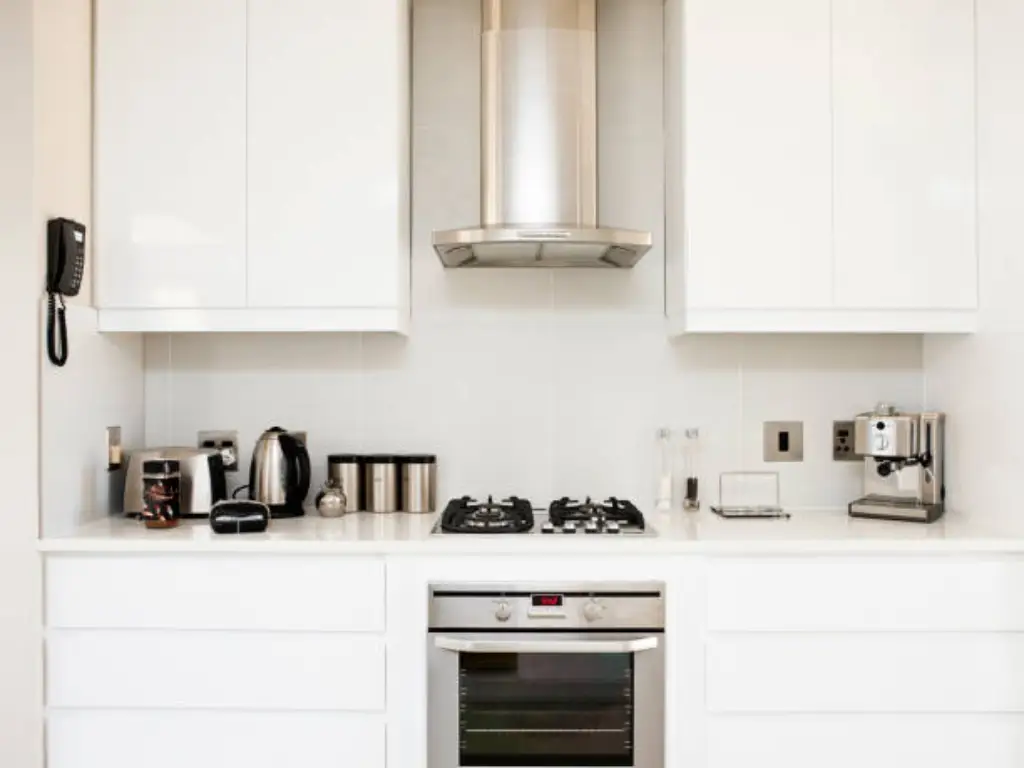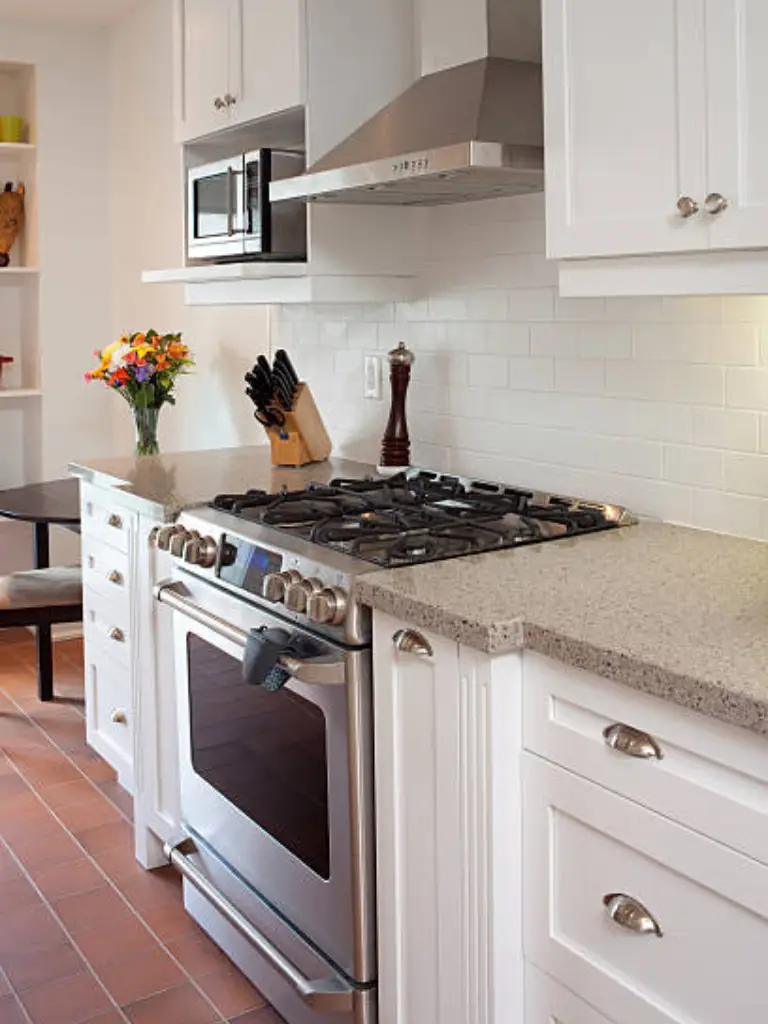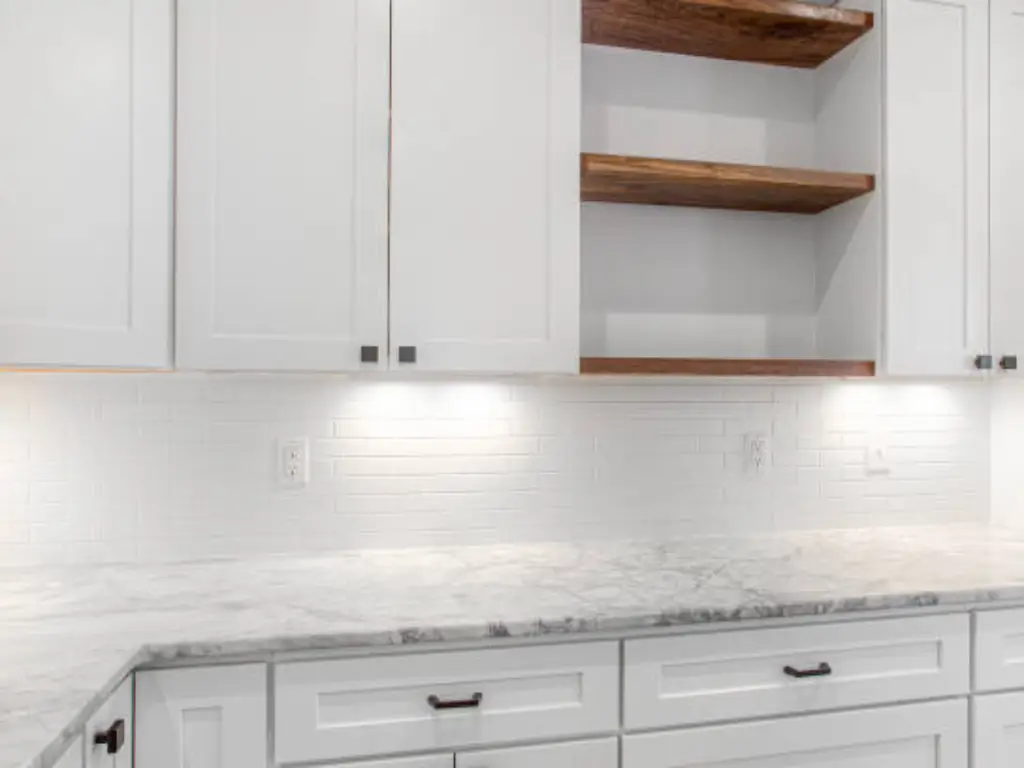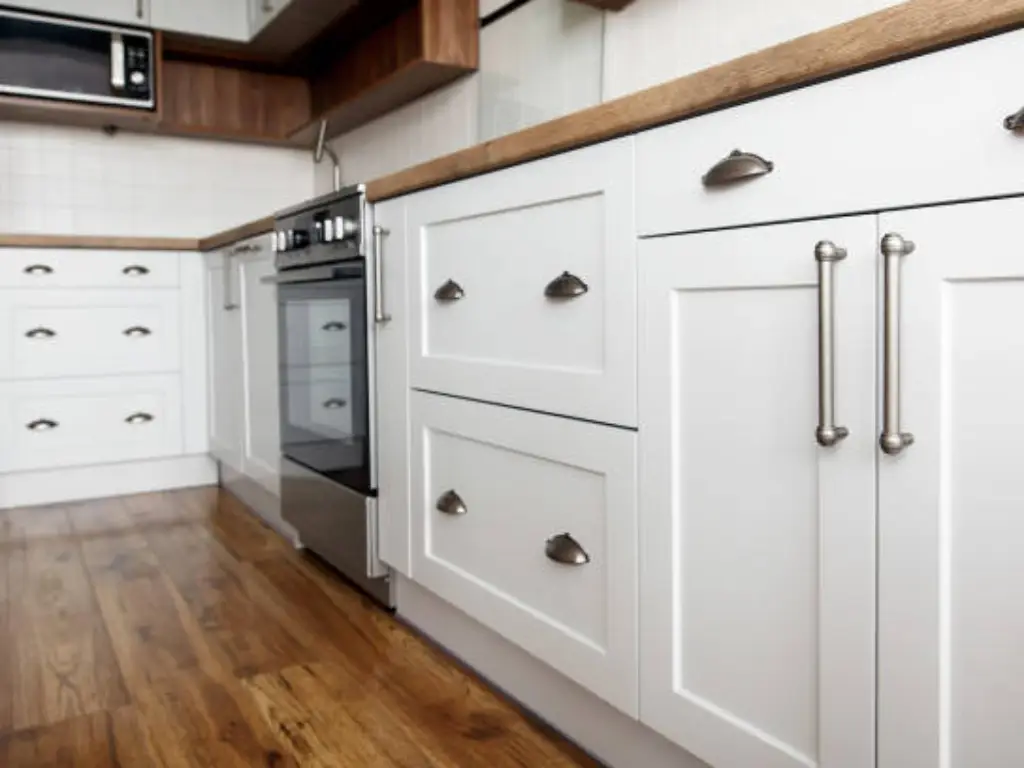Key Highlights
- Discover the basics of shaker cabinet hardware installation and give your kitchen cabinets a facelift with ease.
- Learn to decide on whether to use cabinet knobs or pull handles to suit your style and functionality requirement.
- Become conversant with accurate knob positioning and perfect pull positions on the cabinet doors as well as the drawer fronts.
- Find popular finishes and styles to upgrade the appearance of shaker cabinets, be it a contemporary design or a more traditional vibe.
- Learn to avoid the most common hardware placement errors with professional tips.
- Find the best answers to common doubts regarding the placement of shaker kitchen cabinet hardware.
Introduction
Shaker cabinets are among the few that have retained their popularity over the years due to their timeless design and adaptable nature. Properly placing cabinet knobs, handles, pulls, and other types of shaker kitchen cabinet hardware ideas is essential for both modern and traditional looks, honing elegance. Kitchen cabinet style is defined by more than just its shape; its function-oriented hardware defines style too. In this guide, you’ll learn all the tips, techniques, and tools necessary to accentuate your shaker cabinets beautifully. Let’s get started!
Understanding Shaker Cabinets

The focus of shaker cabinets is simplicity and smooth lines, making them easy to recognize. They feature a five-piece construction which consists of a recessed center panel with stiles and rails surrounding it. This design strikes a balance between simplicity and strength.
Shaker cabinets match any style, modern or traditional, which makes them extremely versatile. They were developed by a religious group in the UK, and later made their way to American homes. They continue to be one of the main choices globally.
Key Features of Shaker Cabinet Design
Shaker cabinets are distinguished by their simple style, which explains why they will always be popular as a type of cabinet in any house. They are characterized by clean lines, and this is attained by using a five-piece construction, with a recessed wood slab at the center, flanked by stiles and rails. The ideal combination of simplicity and sophistication is caught in this minimalist structure.
These cabinets are flexible and can readily accommodate a conventional look with ornate finishing, or swing in a contemporary appearance with minimalist hardware. As an example, shaker cabinets with traditional cup pulls can bring out their vintage beauty, and long bar pulls can bring out their modern beauty.
The uniqueness of the shaker cabinets is that they fit in different room designs. Be it your kitchen, bathroom vanity or laundry room, their timeless style is an excellent choice of cabinetry.
Types of Shaker Cabinet Doors and Drawers
Shaker cabinet doors and drawer fronts are available in a wide variety of choices to match nearly any style. The recessed panel is a favorite among cabinet doors, and the inset adds depth and an interesting look. This choice determines the traditional shaker style used in kitchens and bathrooms.
Also, shaker drawer fronts are common in base cabinets and match stiles and rails around the center panel. These drawer fronts may have different styles, as in deep drawers to heavy storage and slim ones in smaller areas such as vanities.
Some homes have slab-style drawers mixed with shaker cabinets to come up with an interesting combination. You will get hardware placement instructions that will tie these designs together to make sure that they are symmetrical and they are in harmony with the rest of your kitchen or your living area.
Choosing the Right Hardware for Shaker Cabinets

The hardware you choose on your cabinets greatly influences the usability and the aesthetics of a room as well as the aesthetic value of your shaker cabinets. Deciding on knobs, pulls, or a combination of both, consider what kind of hardware would suit your design vision the best, as it can make a big difference in your overall space.
Cabinet knobs are a more traditional feel and pull handles can be considered more modern. Regardless of the choice you like, the alignment of hardware design and the rest of the space is essential to achieve a unified look. So, what are these options? Let us take a closer look!
Knobs vs Pulls: Which Works Best?

Deciding between knobs and pulls can often feel overwhelming. Both styles add elegance while serving as functional elements for your cabinets. Here’s a concise comparison:
| Aspect | Knobs | Pull Handles |
| General Aesthetic | Traditional, classic feel with a simple design. Ideal for a balanced, understated look. | Sleek and modern, offering a contemporary, often minimalistic aesthetic. |
| Placement on Cabinet Doors | Typically centered on the door, creating a centered focal point. Often placed 2.5 to 3 inches from the edge. | Usually placed on the edge or along the top or bottom rail, depending on the cabinet’s design and size. |
| Placement on Drawers | Can be placed in the center of the drawer face, or closer to the top for ease of grip. | Often mounted horizontally in the middle of the drawer or vertically for a more streamlined, functional look. |
| Ease of Use | Requires a twisting motion to open, which can be a bit less ergonomic for large drawers. | Offers a direct pulling motion, making it easier for opening larger drawers, especially heavy ones. |
| Versatility | Works best for smaller cabinets or drawers. Limited to simpler designs. | More versatile, as they can be used horizontally, vertically, or in various custom placements for a tailored look. |
| Best for Heavy Drawers | May not be ideal for heavy drawers unless used in pairs or combined with larger hardware. | Excellent choice for heavy-duty or larger drawers, as they allow for a stronger grip and weight distribution. |
| Combination with Other Hardware | Can be combined with pulls for a more eclectic, semi-modern look. Works well in areas where variety is desired. | Often used alone or in larger spaces, though they can be paired with knobs for a varied look, particularly in kitchens or bathrooms. |
| Space Considerations | Ideal for tighter spaces as they take up less room and are typically smaller in size. | Requires more space, especially long bar pulls. Works better in larger spaces with expansive cabinetry. |
| Cleaning and Maintenance | Easier to clean as they typically have fewer edges and intricate parts. | Can be harder to clean, especially long pulls with intricate designs. Often requires more maintenance due to their size and shape. |
| Compatibility with Shaker Cabinets | Knobs, with their simple and timeless design, work well with Shaker cabinets, complementing the minimalist style. | Pulls also complement Shaker cabinets, offering a slightly more modern twist while retaining functionality. |
Whichever hardware you choose, ensure it complements your drawers, shaker cabinets, and the overall theme of the room.
Popular Hardware Finishes for Shaker Cabinets
Selecting the right finish for your cabinet hardware adds a finishing touch to your kitchen cabinets. Here’s a table of options:
| Finish Type | Features | Aesthetic Impact | Best For |
| Satin Nickel | Timeless, subtle, and versatile. The satin finish provides a soft sheen without being too reflective. | Creates a neutral, sophisticated look that complements both modern and traditional Shaker designs. Its understated appearance blends well with both light and dark cabinet colors. | Ideal for both modern and traditional Shaker kitchens, especially those with neutral tones. |
| Oil-Rubbed Bronze | Rich, dark finish with a vintage, worn-in look. Typically darker than standard bronze, offering a matte, textured surface. | Exudes a warm, antique charm. This finish enhances the traditional, rustic, and farmhouse aesthetics of Shaker cabinets, giving them a more grounded, vintage feel. | Best for rustic, farmhouse, or traditional kitchens and bathrooms with rich wood tones. |
| Polished Chrome | Highly reflective and shiny. Provides a mirror-like finish that is crisp and modern. | Adds a sleek, polished look that works well with contemporary Shaker designs. It can make the cabinet hardware a focal point, reflecting light and brightening the space. | Works well with modern, contemporary, or industrial kitchens that feature clean lines and bright colors. |
| Flat Black | Matte, solid finish with no shine. Provides a stark contrast to the natural wood or lighter-colored cabinet finishes. | Provides a bold, minimalist aesthetic. The flat black finish is dramatic and works well with modern Shaker cabinets, creating a chic, edgy look. | Ideal for modern, industrial, or minimalist Shaker designs, particularly in spaces with white or dark cabinetry. |
| Brushed Brass | A warm, textured finish that combines elegance with a touch of vintage charm. Brushed texture reduces fingerprints and smudges. | Adds warmth and sophistication, creating a refined, transitional look. The brushed texture softens the gold tones, making it less overpowering and perfect for a balanced style. | Perfect for transitional kitchens or spaces that blend traditional and modern elements. Works well with light wood or neutral tones. |
| Antique Pewter | A cooler, darker finish with a slightly muted, rustic appearance. Slightly textured for a vintage appeal. | Gives a subtle, classic look. This finish complements the understated elegance of Shaker cabinets while adding a touch of rustic sophistication. | Best for vintage, rustic, or traditional Shaker kitchens with deep, earthy tones or stone countertops. |
| Polished Brass | Bright and reflective, often associated with a high-end, classic finish. Provides a rich, lustrous appearance that pops. | Offers a high-end, vintage look that creates a luxurious, bold contrast against neutral-toned Shaker cabinets. Works particularly well with dark wood finishes. | Ideal for luxury or traditional Shaker kitchens with dark or rich wooden cabinetry. |
For shaker cabinets, the aesthetics of your chosen finish can transform the mood of any room, from kitchens to bathrooms.
Essential Tools and Preparation for Hardware Installation
The installation of hardware on shaker cabinets needs preparation and the appropriate tools to be accurate. A high-quality cabinet hardware jig can make the task easier and guarantee an accurate positioning.
Be precise and take measurements before drilling holes on your cabinet doors or drawer fronts. Ensure that you have the required spacing tools to make fast repeatable door settings. With these tools and tips, the installation is not only efficient but also professional-looking.
Measuring and Marking for Precision
Precision is the key in mounting hardware on shaker cabinets. Start by marking the location you would like your knobs or pull handles to be, such as a cabinet hardware jig to rapidly establish repeatable door settings.
The next important step is to mark the spots. Using a pencil, lightly indicate where you want the placements on the cabinet doors and the drawer fronts. Keep in mind that any mismatching at this stage may affect the general appearance. Strive to achieve symmetry, particularly with shaker drawer fronts which have recessed panels.
Lastly, recheck all the measurements prior to drilling to make them accurate. This is invaluable with hardware placement tools that have calibrated measurements. These steps will ensure that the installation is efficient and the results are fantastic!
Recommended Tools for DIY Installation
One of the best ways to ensure a flawless installation is by using highly recommended tools.
| Tool Name | Description |
| True Position Tools Cabinet Hardware Jig Pro | Provides quick drawer centering for recessed panels and repeatable settings. |
| Cabinet Hardware Jig Original | Built for small drawers and doors with hardware up to 12 inches. |
| Cabinet Hardware Jig Pro Max | Includes extensions for larger hardware and shelf pins, supporting pieces up to 38 inches. |
| Shaker Drawer Front Spacers | Excellent for stabilizing recessed drawer panels while drilling holes. |
These tools are designed to reduce time and effort while delivering professional-level precision in hardware placement.
Hardware Placement on Shaker Cabinet Doors
The positioning of knobs and cabinet door handles on the doors of shaker cabinets can have a significant effect on the appearance and usability. Some simple guidelines like symmetry and easy access are needed when determining hardware cabinet placement and where to place your hardware.
Select knob location close to the corners to give a traditional look or use vertical pull handles to give a modern feel. Do not forget to consider personal preference without sacrificing utility. We can simplify it further below to get perfect knob and pull placements!

Ideal Knob Placement on Doors
Knobs are usually positioned in strategic locations to improve the symmetry of design and accessibility. In the case of upper cabinets, a common choice is to place knobs 2-3 inches away from the corner of the stile so that they are easily accessible.
When the vanities are in the bathroom or the cabinet doors are taller, it is good to center the knobs vertically on the stile. Maintaining this high position will make the cabinets accessible to users of different heights.
The other good option is to have knobs 1 inch below the bottom of stiles, which provides a smooth finish. The placement should always be in accordance with the overall layout of shaker cabinet doors, which should support aesthetics as well as practicality.
Best Practices for Door Pull Placement
Pull handles offer flexibility of location. The most common location of shaker cabinet doors is vertically on the stile edge, which is ergonomically accessible. This is particularly useful in tall cabinets or upper cabinets.
Horizontal placements are however becoming popular to give it a more modern look. In the case of base cabinets, these horizontal pull handles can be placed slightly above the bottom edges.
When oversized appliance pulls are used, balance them by centering vertically on larger shaker-style cabinet doors. Take into consideration the size and weight of the door to make the right decisions on where to place the hardware.
Would you like me to continue the following sections? Let me know how I can support your blog-writing needs further!
Hardware Placement on Shaker Cabinet Drawers
The choice of hardware position on shaker cabinet drawers has a significant effect on functionality and aesthetics. The placement of pulls and knobs directly on the front of drawers produces a balanced appearance, making them easy to open and follow the clean lines of the shaker design. In case of deeper or wider drawers, it is necessary to adjust the hardware position, which makes it more convenient to use. The use of such tools as a cabinet hardware jig can help to make the right placements on different sizes of drawers to give a professional finish to your kitchen or bathroom cabinetry.
| Hardware Type | Recommended Placement | Purpose & Considerations |
| Knobs on Upper Cabinet Doors | 2-3 inches from the top corner of the stile (vertical placement). | Placing knobs near the top makes them easily accessible, particularly for taller cabinets, while maintaining symmetry. |
| Knobs on Upper Cabinet Doors | Centered vertically on the stile, especially for taller doors. | Ideal for vanities or taller cabinets, ensuring the knob is accessible to users of different heights. |
| Knobs on Lower Cabinet Doors | 1 inch below the bottom of the stile. | This low placement provides a smooth, balanced look and can be ideal for maintaining a clean aesthetic. |
| Pull Handles on Upper Cabinet Doors | Vertically along the stile edge, centered between the top and bottom edges. | Best for easy ergonomic access, especially in tall cabinets. Helps avoid awkward bending or reaching. |
| Pull Handles on Lower Cabinet Doors | Horizontally placed near the bottom edge of the cabinet door (1-2 inches above the edge). | This modern look works well for base cabinets, offering both functionality and a contemporary style. |
| Pull Handles on Large Cabinet Doors | Centered vertically on the door, ensuring balance with oversized or heavy doors. | Useful for larger shaker cabinet doors to provide even weight distribution and an aesthetically pleasing look. |
| Pull Handles on Drawers | Centered horizontally on the drawer front, typically 2-3 inches from the top edge. | Ensures easy access and balance. For deep drawers, consider a slightly higher position for more ergonomic reach. |
| Pull Handles on Deeper/Wider Drawers | Positioned closer to the upper edge (1-2 inches from the top). | For heavier or deeper drawers, this placement reduces strain when opening and ensures a functional design. |
| Cabinet Knobs on Drawers | Typically placed 1-2 inches from the top or bottom edge of the drawer front, centered horizontally. | Balanced placement enhances accessibility and visual appeal. Centering also supports the symmetrical shaker design. |
Centering Pulls and Knobs on Drawer Fronts
The visual balance of the appearance of shaker cabinet drawer fronts is critical in improving the beauty of a room. Centering pulls and knobs help in creating clean lines that are characteristic of a modern kitchen and also offer functionality. To place the hardware in the best possible way, measure the drawer length and find the middle point to place pulls or knobs. The most precise jig positioning can be achieved by using such tools as a cabinet hardware jig, which will result in a smooth and professional look with little to no misalignment between different drawer sizes.
Adjusting Hardware Placement for Deep or Wide Drawers
In the case of deeper or wider drawers, it is possible to rearrange cabinet hardware to improve functionality and style. To make the reach more convenient, particularly with heavier drawers, the pulls or knobs may be placed near the upper edge. Instead, the hardware can be centered along the length of the drawer front to keep the balance and look good. By adjusting to the length of the drawer and taking into consideration the kind of hardware to be used, either bin pulls or cup pulls, you will have a consistent appearance in your cabinetry, which will enhance the overall appearance.
Common Mistakes to Avoid in Hardware Placement
Hardware placement misalignments may interfere with the clean, modern look that shaker cabinets are famous to have. Such problems are usually caused by improper measurements or uneven installation procedures. To prevent these mistakes, a cabinet hardware jig should be used, which will allow accurate and repeatable positioning. The time spent measuring twice and marking the center of each drawer front, particularly in cabinetry of different sizes, will help to keep a balanced and polished look. Specifically, tools such as those offered by True Position Tools are very useful in minimizing alignment errors and ensuring uniform results on all sides of the cabinet.
Besides the accurate positioning, the consistent style of the hardware used in the kitchen is also an important factor in creating the visual harmony. Combining various types of hardware, e.g. bar pulls and bin pulls, may create a discontinuous appearance. Rather, choose similar designs and finishes on all the cabinet doors and drawers to give a harmonious look. Shaker cabinets are also compatible with minimalist, sleek hardware, which makes it more convenient to choose matching items. When you combine functionality with a unified style, you will be able to improve the functionality and the aesthetic value of your kitchen cabinets.
Discovering Maxave: Innovative Cabinet Hardware Solutions
More Than A Furniture Hardware Manufacturer
Your Sales Growth Specialist
Maxave is more than just a hardware manufacturer; we drive your growth. With an annual production capacity of 500 million hinges, 30 million drawer sliders, and 12,000 tons of edge banding, we meet your demands at scale. Our advanced galvanizing technology offers 200% enhanced anti-rust protection and a 99.1% yield rate, ensuring durable, reliable products that give you a competitive advantage.
Maxave is a worldwide B2B manufacturer of cabinet hardware, and it only serves distributors, wholesalers, and large-scale furniture manufacturers. Maxave is a company with a keen interest in innovation and accuracy and deals with high-quality hinges, drawer slides, and cabinet handles that are performance-oriented. They have state-of-the-art production facilities and high quality control to ensure that all the components are of international standards, which makes Maxave a favorite OEM/ODM partner in the cabinet and furniture industry.
Whether it is a contemporary shaker kitchen or a classic cabinetry project, Maxave has a wide range of finishes and styles that are designed to suit the different regional market needs. Their solutions are scalable, reliable, and long-term value whether it is sleek bar pulls or soft-close systems. When you incorporate the cabinet hardware of Maxave into your product line, B2B partners not only have access to consistent, high-quality components but also the benefit of an efficient supply chain that is optimized to distribute globally.
Conclusion
The ideal hardware positioning on shaker cabinets contributes a lot to the beauty of the kitchen. Taking into account a number of factors such as the depth and width of the drawers, as well as the kind of hardware you use, you can make not only a functional but also a beautiful space. Preventing the most common errors will help the cabinet hardware to be a part of a unified design. Finally, it is all about personal taste, so it is important to select the styles and placements that appeal to your practical and aesthetic vision of your home.
Frequently Asked Questions
Where should hardware be placed on shaker cabinet doors?
In the case of shaker cabinet doors, pulls and knobs are usually centered on the vertical parts of the door. Instead, placing them at the same height, approximately 2-3 inches above or below the top or bottom edge, offers a harmonious look, and at the same time, makes them functional.
What size pulls work best for shaker drawers?
In the case of shaker drawers, 4 to 6 inches long pulls are usually the best choice. This is a size that is both functional and aesthetic, easy to use and that fits well with the clean lines of shaker cabinetry. The width of the drawer should always be taken into consideration to have the best proportions.







